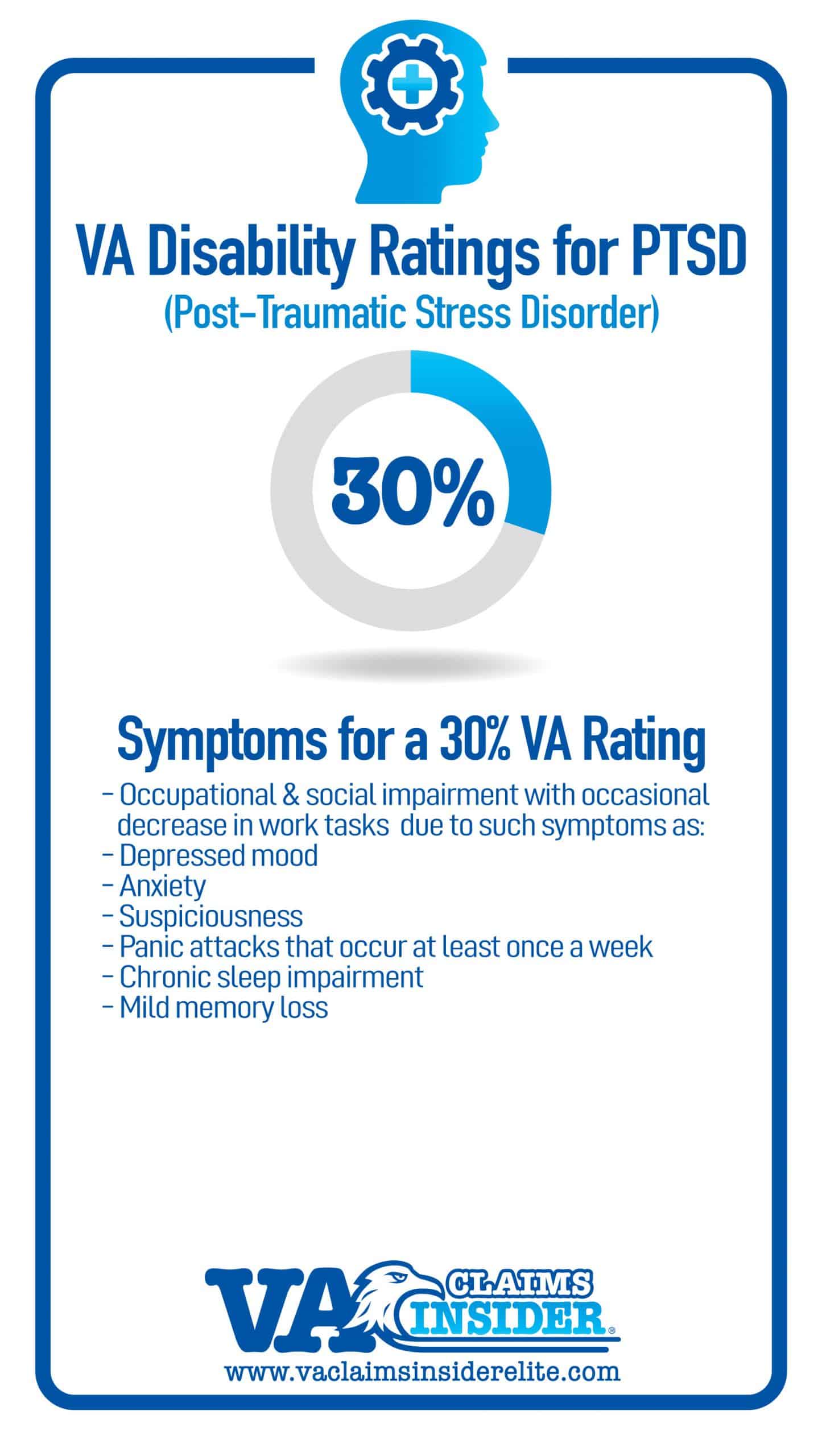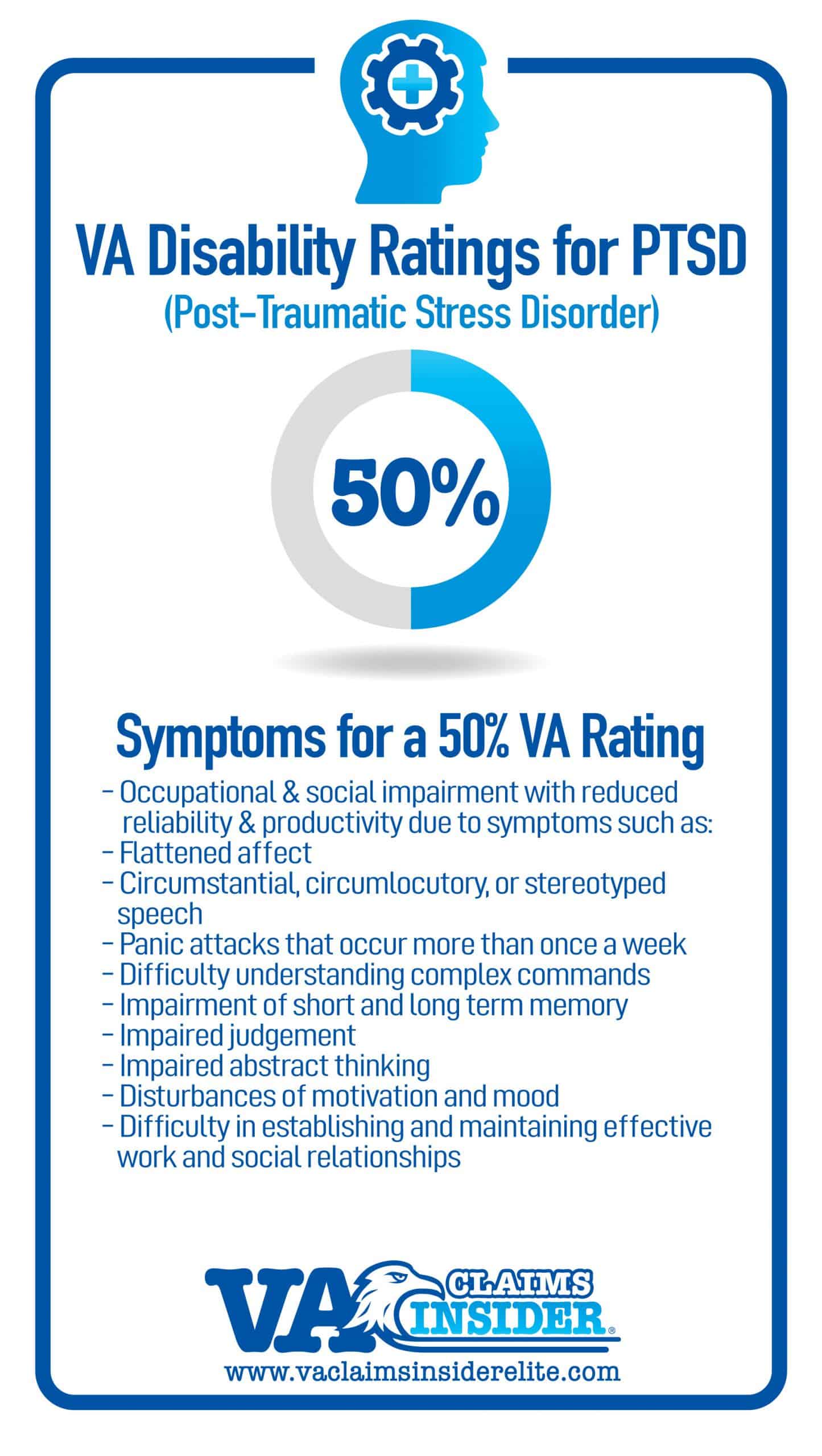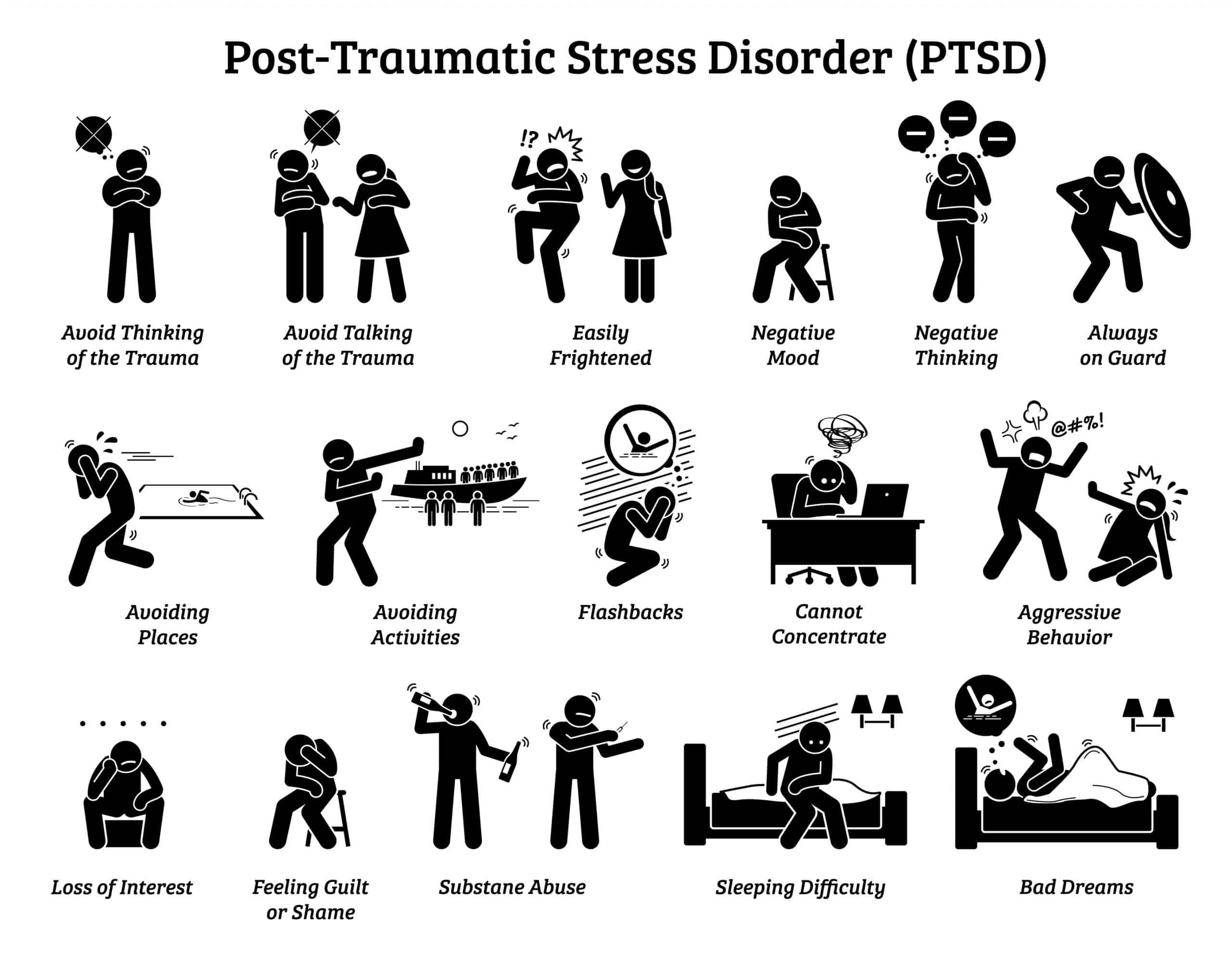VA PTSD Rating Criteria Explained
Hi Veterans, in this post, we will be exploring the VA PTSD Rating Criteria in detail.
VA ratings for PTSD depend on the frequency, severity, and duration of a veteran’s mental health symptoms over time.
The more severe the veteran’s PTSD symptoms (and the more negative impact those symptoms have on his/her occupational and social impairment), the more likely it is for a veteran to get a higher VA disability rating for PTSD.
In 2020, the average VA rating for PTSD is currently 70 percent, but veterans can be rated from 0 percent to 100 percent with breaks at 10 percent, 30 percent, 50 percent, and 70 percent.
But first, let’s take a minute to explore 38 CFR for PTSD regarding the level of occupational and social impairment for each VA PTSD rating criteria.
List of Detailed Posts About the VA PTSD Rating Criteria
- Click to read about the 0% and 10% VA ratings for PTSD now.
- What about the 30 VA rating for PTSD? Click HERE to read now.
- Think you deserve an automatic 50 VA rating for PTSD? Click HERE to read now.
- Maybe even a 70% VA rating for PTSD? Click HERE to read now.
- How about a 100% VA rating for PTSD? Click HERE to read now.
PTSD is the #3 Most Commonly Claimed VA Disability
According to the Top 10 Most Common VA Disability Claims data, PTSD is in the top three across all veteran demographics.
Here’s some interesting “insider” VA data regarding the VA PTSD rating criteria for veterans receiving VA disability compensation for PTSD in CY 2019:
- 2.2% of all VA disability recipients for PTSD have a 0% PTSD rating.
- 7.1% of all VA disability compensation claim recipients for PTSD have a 10% VA rating for PTSD.
- 23.7% of all VA compensation claim recipients for PTSD have a 30% VA PTSD rating.
- 25.9% of all VA disability recipients for PTSD have a 50% PTSD rating.
- 28.0% of all VA claim recipients for PTSD have a 70% rating for PTSD.
- 13.1% of all VA disability claim recipients have a 100% PTSD rating.
>> Want to learn more about PTSD Ratings in 2020? Click HERE now!
CFR Title 38, Part 4, the Schedule for Rating Disabilities lists the general VA PTSD rating criteria.
In 2020, PTSD VA ratings range from 0% to 100%, with interim breaks at 10%, 30%, 50%, and 70%.
2020 VA PTSD Rating Criteria from 0% to 100%
0% VA disability rating for PTSD
A mental condition has been formally diagnosed, but symptoms are not severe enough either to interfere with occupational and social functioning or to require continuous medication.
10% VA disability rating for PTSD
Occupational and social impairment due to mild or transient symptoms which decrease work efficiency and ability to perform occupational tasks only during periods of significant stress, or symptoms controlled by continuous medication.

30% VA disability rating for PTSD
Occupational and social impairment with occasional decrease in work efficiency and intermittent periods of inability to perform occupational tasks (although generally functioning satisfactorily, with routine behavior, self-care, and conversation normal), due to such symptoms as: depressed mood, anxiety, suspiciousness, panic attacks (weekly or less often), chronic sleep impairment, mild memory loss (such as forgetting names, directions, recent events).

50% VA disability rating for PTSD
Occupational and social impairment with reduced reliability and productivity due to such symptoms as: flattened affect; circumstantial, circumlocutory, or stereotyped speech; panic attacks more than once a week; difficulty in understanding complex commands; impairment of short- and long-term memory (e.g., retention of only highly learned material, forgetting to complete tasks); impaired judgment; impaired abstract thinking; disturbances of motivation and mood; difficulty in establishing and maintaining effective work and social relationships.

70% VA disability rating for PTSD
Occupational and social impairment, with deficiencies in most areas, such as work, school, family relations, judgment, thinking, or mood, due to such symptoms as: suicidal ideation; obsessional rituals which interfere with routine activities; speech intermittently illogical, obscure, or irrelevant; near-continuous panic or depression affecting the ability to function independently, appropriately and effectively; impaired impulse control (such as unprovoked irritability with periods of violence); spatial disorientation; neglect of personal appearance and hygiene; difficulty in adapting to stressful circumstances (including work or a worklike setting); inability to establish and maintain effective relationships.

100% VA disability rating for PTSD
Total occupational and social impairment, due to such symptoms as: gross impairment in thought processes or communication; persistent delusions or hallucinations; grossly inappropriate behavior; persistent danger of hurting self or others; intermittent inability to perform activities of daily living (including maintenance of minimal personal hygiene); disorientation to time or place; memory loss for names of close relatives, own occupation, or own name.

How the VA Rater Determines Your PTSD Rating
A common misunderstanding among veterans is that you need to meet ALL the subjective symptoms tied with a certain rating criterion for PTSD in order to get that rating on the PTSD rating scale.
Veterans, this is far from the truth and not in accordance with the law!
The Rating Veteran Service Representative (RVSR) will consider all the evidence of record, and normally will assign the VA rating for PTSD that includes the “preponderance of the symptoms.”
For example, if a veteran has 4 of the symptoms from the 50% PTSD rating criteria and 6 of the symptoms from the 70% PTSD rating criteria, the rating agency shall assign the HIGHER RATING, unless evidence of record contradicts this subjective assessment.
The opposite is also true.
For example, if a veteran has 6 of the symptoms from the 30 rating for PTSD criteria and 4 of the symptoms from the 50 PTSD VA rating criteria, the rating agency shall assign the lower rating, unless evidence of record contradicts this subjective assessment.

Another important point is that the list of symptoms for each mental health rating in the VA PTSD rating criteria is NOT all-inclusive, thus they are NOT an exhaustive list to be applied rigidly.
When determining the appropriate disability evaluation to assign, the VA Raters primary consideration is a veteran’s symptoms, but it must also determine how those symptoms impact a veteran’s occupational and social impairment. See Vazquez-Claudio v. Shinseki, 713 F.3d 112 (Fed. Cir. 2013); See Mauerhan v. Principi, 16 Vet. App. 436, (2002).
The use of the term “Such As” in the CFR 38 rating criteria for mental health conditions demonstrates that the symptoms after that phrase are NOT intended to constitute an exhaustive list, the VA Rater need not find the presence of all, most, or even some, of the enumerated symptoms to award a specific rating. See Sellers v. Principi, 372 F.3d 1318 (Fed. Cir. 2004).
However, all VA PTSD Rating Criteria are also associated with objectively observable symptomatology and the plain language of the regulation makes it clear that the veteran’s impairment must be “Due To” those symptoms, a veteran may only qualify for a given disability rating by demonstrating the particular symptoms associated with that percentage, or others of similar Frequency, Severity, and Duration. See Vazquez-Claudio, 713 F.3d at 118.
Three Primary Rules for the VA PTSD Rating Criteria
According to §4.126, evaluation of disability from mental disorders, the VA Rater is required to consider these three rules:
- Rule #1. When evaluating PTSD, the rating agency shall consider the frequency, severity, and duration of psychiatric symptoms, the length of remissions, and the veteran’s capacity for adjustment during periods of remission. The rating agency shall assign an evaluation based on all the evidence of record that bears on occupational and social impairment rather than solely on the examiner’s assessment of the level of disability now of the examination.
- Rule #2. When evaluating the level of disability for PTSD, the rating agency will consider the extent of social impairment but shall not assign an evaluation solely based on social impairment.
- Rule #3. §4.7 Higher of Two Evaluations. Where there is a question as to which of two evaluations shall be applied, the higher evaluation will be assigned if the disability picture more nearly approximates the criteria required for that rating. Otherwise, the lower rating will be assigned.
About the Author
Brian Reese is a VA disability claim expert, former Air Force captain, and founder of VA Claims Insider – “The Most Trusted Name in Education-Based Resources for Veterans.”
Learn more About VA Claims Insider HERE.
Brian’s frustration with the 8-step VA disability claims process led him to create “VA Claims Insider,” which provides disabled veterans with tips, strategies, and lessons learned to win their VA disability compensation claim in less time.

He is also the CEO of Military Disability Made Easy, which is the world’s largest free searchable database for all things related to DoD disability and VA disability, and has served more than 6,000,000 military members and veterans since its founding in 2013.
Veterans can download one of his #1 most downloaded FREE eBooks: “The Secret Guide to 833 Ratable VA Disabilities” by clicking HERE now.
Brian is a former active duty Air Force officer with extensive experience leading hundreds of individuals and multi-functional teams in challenging international environments, including a combat tour to southern Afghanistan in 2011 in support of Operation ENDURING FREEDOM.
Brian is a Distinguished Graduate of Management from the United States Air Force Academy, Colorado Springs, CO and he holds an MBA from Oklahoma State University’s Spears School of Business, Stillwater, OK, where he was a National Honor Scholar (Top 1% of Graduate School class).
